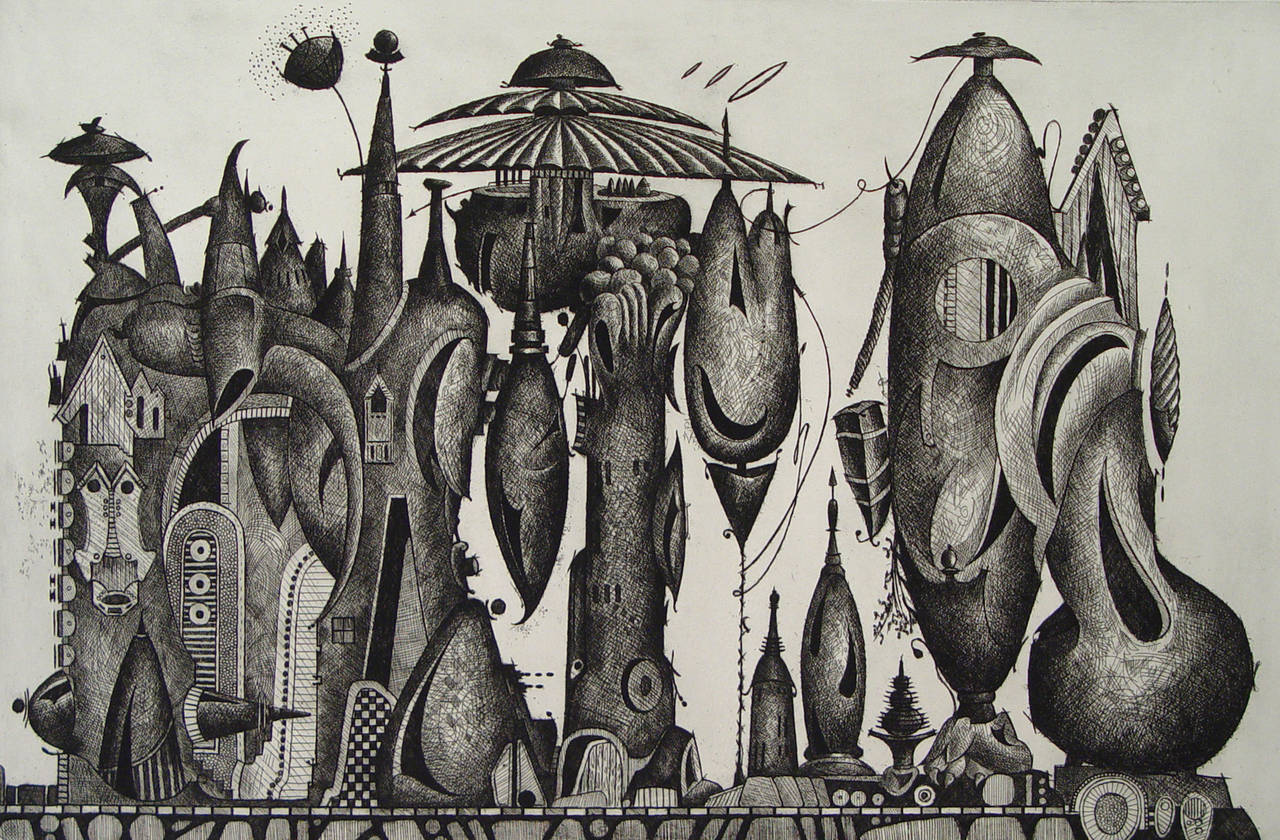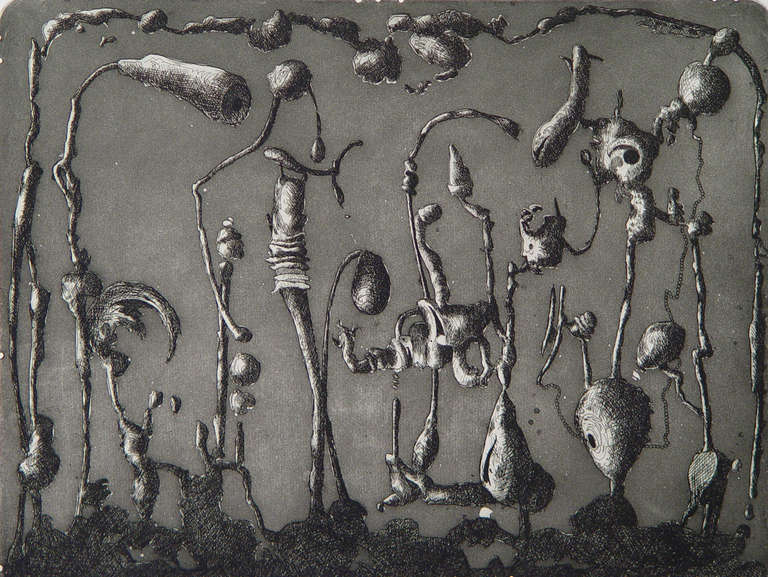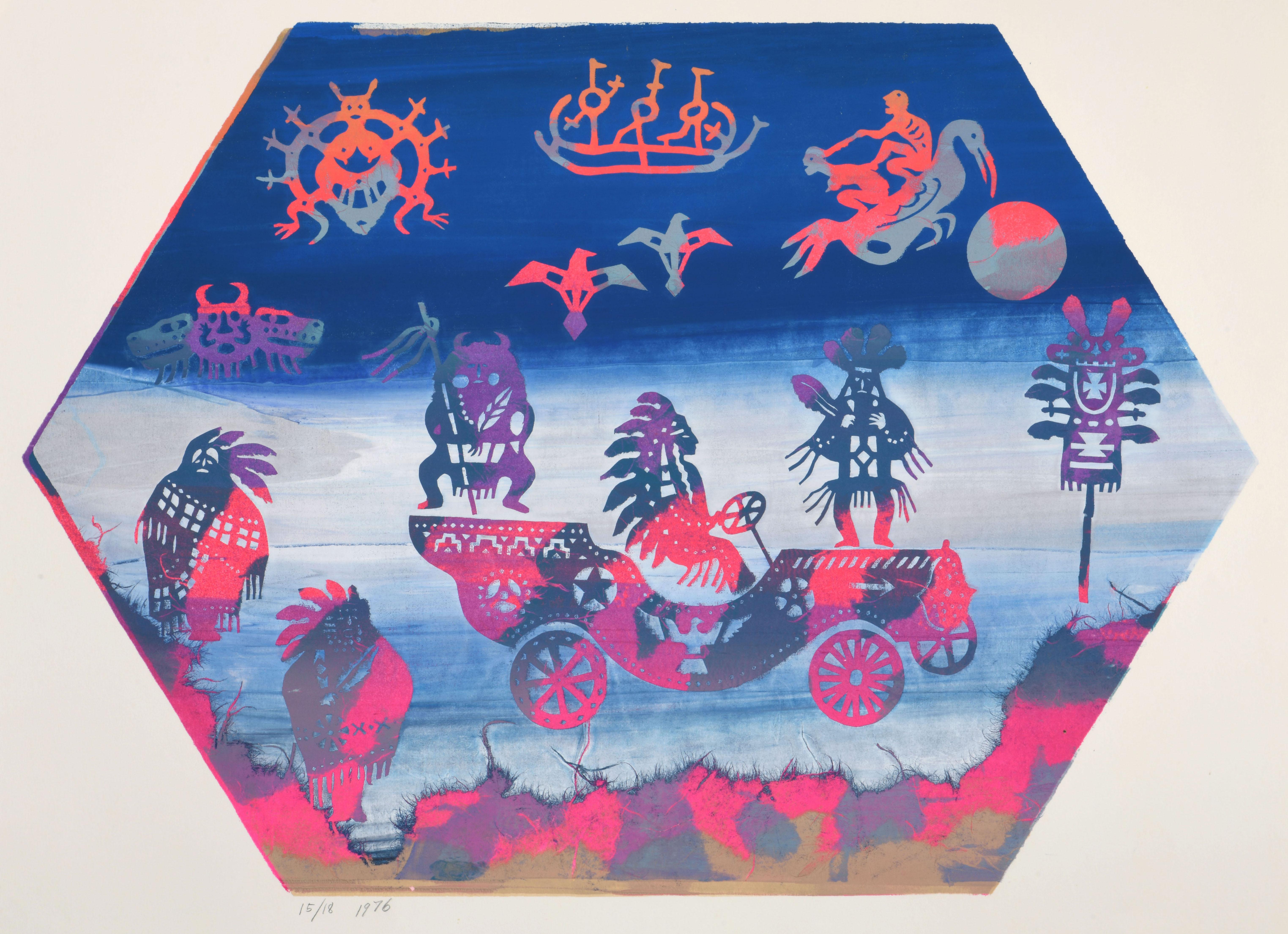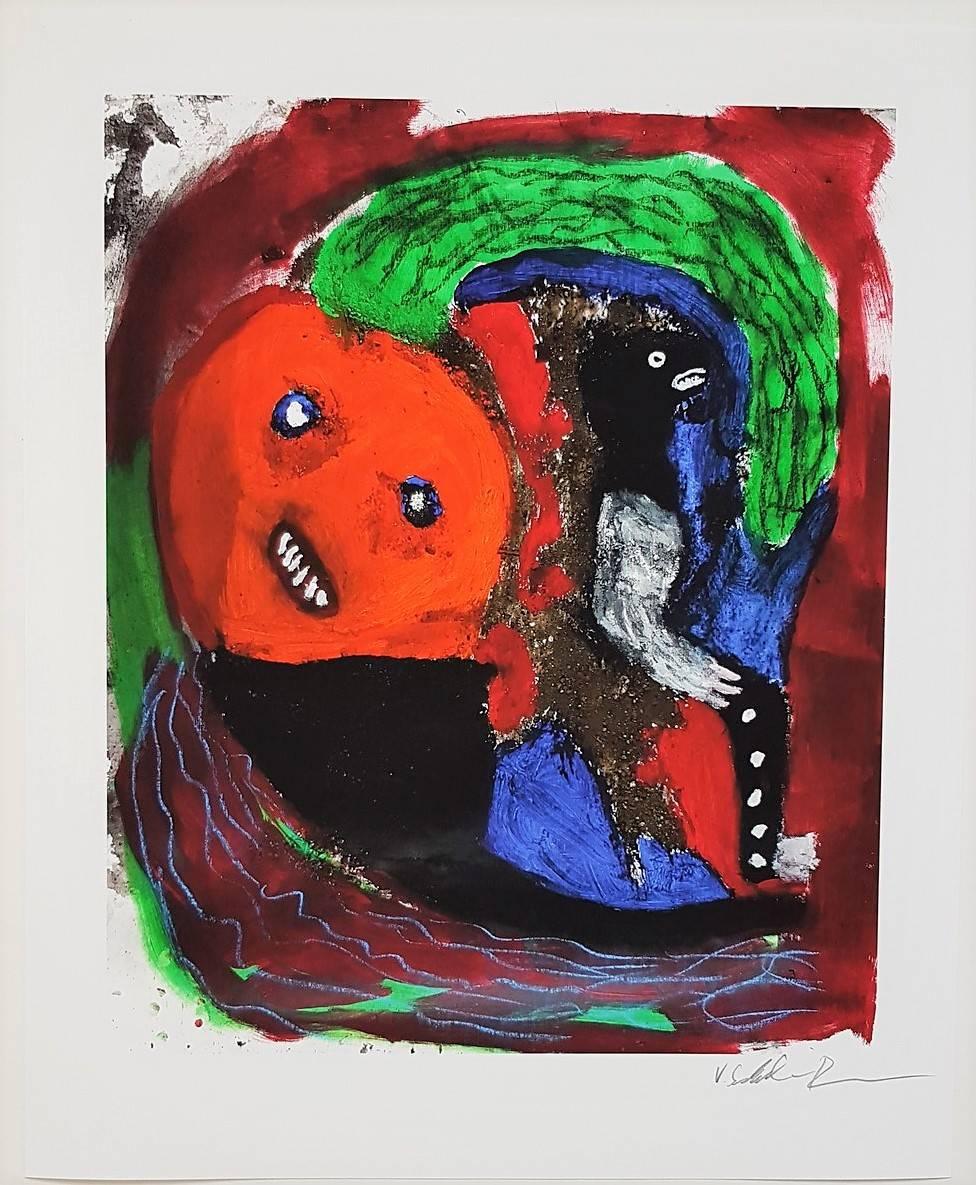Want more images or videos?
Request additional images or videos from the seller
1 of 5
Hector RuizDaybed Daydream2006
2006
About the Item
copper etching with aquatint
The power of memory and how it recalls individuality begins in such basic experiences as the ability to link internal ideas to external manifestations of those ideas. Memories as simple as an old toy or a street can set off a chain reaction of thoughts that snowball into issues as broad as nationalism, identity politics or a body politic to name a few. Hector Ruiz’s works encompass the broad, complex and often painful world particular to the Arizona and neighboring Mexican landscape. United States and Mexican border issues, immigration conflicts of gender and sexuality and urban development oblivious to the needs of the individual and the landscape create a combinative world that is seen through Ruiz’s own emotionally critical lens instead of through a universal one.
Having grown up in the border states of Texas and Arizona and spending many summers visiting family in Piedras Negras, Mexico, Ruiz consciously chooses to reside in Arizona because it is the most conservative of the border states. He prefers the conservatism because it is matched only by a rigorous activism that attempts to protect Mexican immigrants. Interminable debates of nation and rights are central to the life o any Arizonan. The fluidity of culture and peoples that are an effect of the border reinforce ongoing tensions such as nationalism versus cosmopolitanism, fragmentation versus unity, group mentalities versus individual ones and host of others.
Uncanny in its historical reflection, the same set of clashed existed in pre- and postwar Germany at the turn of the 20th century. A country faltering within its own fluid borders, its people felt their national, thus personal, identity slipping away in the face of internationalism, urbanism and industry. The vitality inherent to polarization, however, gave birth to the German Expressionist movement that became such a crucial facet of 20th century Modernism. Although late 19th and early 20th century Germany’s search for one nation/one identity is notably less complex than the United States’ Mexican border issues of today; there is a comparable rift in identity experienced by both Mexicans and Americans in addition to the difficulties that originate from the continuous social readjusting necessitated by globalization.
Lightly referencing many of the various schools and artists from the 30-some year period of German Expressionism, Ruiz draws a singular inspiration from the artist max Bachmann. Beckmann, the German Expressionist who defies many of his contemporaries with an insistent individuality, develops his own language through paintings and prints using tense, conflicted compositions, broad, black lines, and densely inhabited surfaces that bow with tension of their relationship to the two-dimensional background.
More contemporary artists who emerge in Beckmann’s wake also create fertile ground for Ruiz. In the late 1960’s and 1970’s, Phillip Guston’s strong, choppy lines and use of black as a color (in sushc a way that it is an unmistakable nod to Beckmann) makes way for his subject matter fo bodies, body parts and heads. In the 1980’s Jean-Michel Basquiat also make reference to both Beckmann and Guston, with his abundant use of bodies, body parts, animals, archetypal symbols, figures and densely packed surfaces.
Undoubtedly these influences transform into a hybrid mixture when seen in conjunction with 19th century Mexican political cartoonist Jose Guadelupe Posada’s works. Posada’s cartoons are ubiquitous stylistically and are still used in modes of Mexican popular art today. The cartoonish, raw, woodblock print style of skeletons lampooning reporters and political figures parallel the vision of the aforementioned artists who drive toward the truth at breakneck speed. Like his forebears, Ruiz uses truth as a weapon or tool employing the “ancient, traditional and deep-rooted foundations” of his Mexican, Native American and American background to wrench back the veil of over-development, the sterilizing effects of globalization and the havoc wreaked by border conflicts.
After graduating with a Bachelor of Fine Arts degree from Arizona State University in 1994, Ruiz quickly sought out alternative forms of art making and thought. He traveled extensively in India and asia, where he co-opted ancient spiritual texts such as the Bhagavad-Gita and forms of Buddhist thought to help lay the groundwork for ideas that have fueled his current work.
Woodcarvings and linoprints are his chosen mediums. Benefiting from the advantages of being self-taught in these skills, Ruiz’s woodcutting abilities concisely express his artistic intent. He is able to create and resource personal, visual statements and language through themes and repetitive images as well as make strong reference to craft in a way that transforms the strictures of ”folk” art into a forceful regional language.
- Creator:Hector Ruiz (American)
- Creation Year:2006
- Dimensions:Height: 18 in (45.72 cm)Width: 14.5 in (36.83 cm)
- More Editions & Sizes:1 x 10Price: $1,100
- Medium:
- Movement & Style:
- Period:
- Condition:
- Gallery Location:Phoenix, AZ
- Reference Number:1stDibs: LU13712994142
About the Seller
5.0
Gold Seller
These expertly vetted sellers are highly rated and consistently exceed customer expectations.
Established in 1984
1stDibs seller since 2012
61 sales on 1stDibs
- ShippingRetrieving quote...Ships From: Phoenix, AZ
- Return PolicyA return for this item may be initiated within 3 days of delivery.
More From This SellerView All
- Becoming the ClownBy Hector RuizLocated in Phoenix, AZCopper etching with aquatint The power of memory and how it recalls individuality begins in such basic experiences as the ability to link internal ideas to external manifestations of those ideas. Memories as simple as an old toy or a street can set off a chain reaction of thoughts that snowball into issues as broad as nationalism, identity politics or a body politic to name a few. Hector Ruiz’s works encompass the broad, complex and often painful world particular to the Arizona and neighboring Mexican landscape. United States and Mexican border...Category
Early 2000s Street Art Figurative Prints
MaterialsCopper
- Untitled Etching / Suite of 4By Martin MullLocated in Phoenix, AZetching; unframed available editions: 1, 2 and 3 of 20Category
1990s Abstract Prints and Multiples
MaterialsArchival Paper, Etching
- WOP 2-00600By Hiro YokoseLocated in Phoenix, AZmixed media on paper Image size: 15 x 12.5 inches Neoromantic painter Hiro Yokose fuses multiple layers of wax and oil paint to create mysterious, veiled landscapes illuminated wit...Category
Early 2000s Minimalist Abstract Drawings and Watercolors
MaterialsMixed Media, Archival Paper
- WOP 2-00602 (H)By Hiro YokoseLocated in Phoenix, AZmixed media on paper Image size: 12.75 x 24 inches Neoromantic painter Hiro Yokose fuses multiple layers of wax and oil paint to create mysterious, veiled landscapes illuminated wi...Category
Early 2000s Abstract Abstract Drawings and Watercolors
MaterialsMixed Media, Archival Paper
- Fractal Dance IXBy Mark PomilioLocated in Phoenix, AZcharcoal on paper Mark Pomilio’s method, motives, and conceptual considerations are centered on visually articulating recent developments in the life sciences. It is not his intent ...Category
2010s Abstract Geometric Drawings and Watercolor Paintings
MaterialsCharcoal, Archival Paper
- Fractal Dance VIIIBy Mark PomilioLocated in Phoenix, AZcharcoal on paper Mark Pomilio’s method, motives, and conceptual considerations are centered on visually articulating recent developments in the life sciences. It is not his intent ...Category
2010s Abstract Geometric Abstract Drawings and Watercolors
MaterialsCharcoal, Archival Paper
You May Also Like
- Eagle's NestBy Valton TylerLocated in Dallas, TXIn The New York Times Arts in America column, Edward M. Gomez writes of Valton Tyler, "visionary seems the right word for describing his vivid, unusual and technically refined paintings, prints and drawings, whose style defies convenient labels. Abstract, surreal, cartoonish, sci-fi fantastic, metaphysical, apocalyptic-Baroque - all of these fit but also fall short of fully describing his art." (The Living Arts, June 13, 2000, p. B2) Valton Tyler was born in 1944 in Texas, where "the industrial world of oil refineries made a long-lasting impression on Valton as a very young child living in Texas City." (Reynolds, p. 25) After leaving Texas City, Valton made his way to Dallas, where he briefly enrolled at the Dallas Art Institute, but found it to be too social and commercial for his taste. After Valton's work was introduced to Donald Vogel (founder of Valley House Gallery), "Vogel arranged for Tyler to use the printmaking facilities in the art department of the Southern Methodist University in Dallas, where the young artist essentially taught himself several demanding printmaking techniques. 'It was remarkable,' Vogel says. 'Not only did he learn complicated etching methods, but he was able to express himself powerfully in whatever medium he explored.' Vogel became the publisher of Tyler's prints. Among them, the artist made editions of some 50 different images whose sometimes stringy abstract forms and more solid, architecturally arresting elements became the precursors of his later, mature style." (Gomez, Raw Vision #35, p. 36) "Eagle’s Nest" is Plate Number 37, and is reproduced in "The First Fifty Prints: Valton Tyler" with text by Rebecca Reynolds, published for Valley House Gallery by Southern Methodist University Press, Dallas, Texas, 1972. In "The First Fifty Prints," Reynolds provides the following quote from the artist regarding this print: “The structure on the right is an architectural symbol for an eagle. It is also like a machine that is igniting the shape on the left. Below, the egg that is coming out of the chute is a child which will evolve into another architectural eagle...Category
1970s Outsider Art Prints and Multiples
MaterialsRag Paper, Etching, Aquatint
- The Gun, intaglio print from copper plate, chine-collé with Japanese paperLocated in Toronto, OntarioTHE GUN by Rocky Dobey is an intaglio print from an acid-etched copper plate, chine-collé with Japanese paper on archival Hahnemuhle paper, mounted...Category
21st Century and Contemporary Outsider Art Figurative Prints
MaterialsGlass, Paint, Archival Paper, Handmade Paper, Engraving, Etching, Intaglio
- Freezing PointBy Valton TylerLocated in Dallas, TXIn The New York Times Arts in America column, Edward M. Gomez wrote of Valton Tyler, "visionary seems the right word for describing his vivid, unusual and technically refined paintin...Category
1970s Outsider Art Figurative Prints
MaterialsRag Paper, Etching
- TrappedBy Valton TylerLocated in Dallas, TXIn The New York Times Arts in America column, Edward M. Gomez wrote of Valton Tyler, "visionary seems the right word for describing his vivid, unusual and technically refined paintin...Category
1960s Outsider Art Figurative Prints
MaterialsEtching
- "Sitting Bull Goes To Washington"Located in Washington, DCSilkscreen work by Noche Crist (1909- 2004). Work is from from her "Sitting Bull Goes to Washington" series. Marked in pencil 15/18 lower left. Printed in 1976 by the artist. Catalo...Category
1970s Outsider Art Figurative Prints
MaterialsPaper
- PumpkinheadBy Volkmar Schulz-RumpoldLocated in Kansas City, MOVolkmar Schulz-Rumpold Title: Pumpkinhead Medium: Original Pigment Print, on handmade cotton paper Year: 2017 Signed by hand Size: 19.5 × 16.0 on 23.8 × 19.5 inches COA provided Vol...Category
2010s Outsider Art Prints and Multiples
MaterialsHandmade Paper, Archival Pigment
Recently Viewed
View AllMore Ways To Browse
Summer Daybed
Mexico Border
American Sterilizer
Japanese Woodblock Prints Utamaro
Antique French Clocks Parts
Spirit Of St Louis Model
Salvador Dali Signed Prints Bullfight
Paulo Monteiro
Reinhold Lepsius
Book Ends Tiny
Charles Monnet
Fins De Siecles Brussels
Franklin Library Lot
Gordon Ward
Howard Behrens On Sale
Itzchak Tarkay Lithograph
Josef C Diamonds
Lester Johnson On Sale





